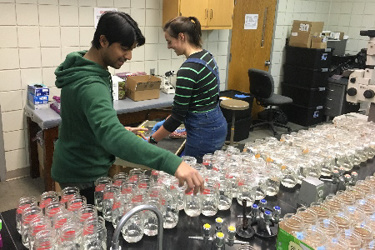Innovative Research Explores Impacts Of Tile Drainage Water Quality On Streams

Cover crops were almost as effective as restored prairie at reducing nitrate concentrations in tile-drained water, according to recent research at Iowa State University.
This was one of the key findings from a study led by Marshall McDaniel, associate professor of agronomy at Iowa State. The project was designed to better understand how the quantity and quality of tile drainage water impacts in-stream potential for nutrient enrichment, leading to growth of algae and depletion of vital oxygen in aquatic ecosystems.
McDaniel’s research collaborators included Mriganka De, a former postdoctoral research associate; Michael Thompson, professor of agronomy; Matt Liebman, professor of agronomy; Theresa Brehm, former undergraduate in agronomy; Grace Wilkinson, a former assistant professor in ecology, evolution and organismal biology (now at the University of Wisconsin); and Matthew Helmers, professor of agricultural and biosystems engineering. The project was funded by the Iowa Nutrient Research Center.
Subsurface tile drainage is used in over 40% of Midwestern farm fields to improve crop yields, but tile systems often bypass natural buffers to deliver nutrient-laden water directly to waterways. The resulting in-stream changes can set in motion the eutrophication process that leads to harmful algal blooms and associated public health issues.
“It’s not easy to study streams. They are dynamic biologic systems that tend to vary rapidly over space and time,” McDaniel said. “Different types of streams also have unique characteristics, including their own unique history of prior nutrient loadings. This likely affects how streams respond to land-use changes within their watershed – sometimes in surprising ways. One of the primary guiding questions in designing this study was, will ‘pristine’ streams be impacted differently by increased nutrients from land-use induced management changes than streams that have had a history of receiving high nutrient loads? Our results helped answer some questions, but also raised new ones.”
The team’s innovative approach to gauge the impact of tile water inputs into streams with varying “nutrient histories” required four main steps:
- First, the team collected water from Iowa streams considered to have historically high, medium and low impacts from nutrients.
- Second, the researchers sampled water from subsurface tile flow under test plots managed with three different treatments (a corn-soybean rotation, cover crops and restored prairie).
- The third step took place in the lab: Water from the tiles and streams were mixed in ratios typically found where tiles drain into streams at two different times of the year -- spring and fall. Then the water was incubated at moderate temperatures for two weeks before analysis.
- The fourth and final step also happened in the lab: Changes in algal growth, measured as chlorophyll a and dissolved oxygen, both indicators of eutrophication, were monitored at the beginning and end of the experiment.
When the results came in, it was no surprise the tile-drained water from cover crops and restored prairie caused less algal growth. This is good news for farmers and the state investing in these practices.
“What was not really anticipated was that the cover crop performed almost as well as the prairie overall,” McDaniel said. Water draining from test plots with a winter rye cover crop reduced growth of algae by 43% compared to tile drainage from plots in the conventional corn-soybean rotation. Drainage from restored prairie areas reduced growth of algae by 46% compared to the conventional system.
Something else the researchers did not fully predict was the influence of prior stream condition on the oxygen decrease from the three management practices.
“In the spring and fall water samples, more pristine streams seemed to be more sensitive to tile drainage water -- especially water from corn-soybean rotation (business as usual management). What that says to me, is that our most pristine streams are in greater danger of eutrophication if you change land uses in that watershed to ones that will increase stream nutrient loads,” McDaniel said. “We’d really like to study this further, but our findings suggest that a stream’s history of background nutrients influences how it will react to an increase in nutrients. All the more reason to give special attention to our higher-quality streams.”
McDaniel and his team have a final report with poster summary on the Iowa Nutrient Research Center website.
About The Iowa Nutrient Research Center
The Iowa Nutrient Research Center was established by the Iowa Board of Regents in response to legislation passed by the Iowa Legislature in 2013. The center pursues science-based approaches to evaluate the performance of current and emerging nutrient management practices and to provide recommendations on implementing the practices and developing new practices. Iowa State University leads the partnership that includes the University of Iowa and the University of Northern Iowa.
Source: Iowa State University of Science and Technology
